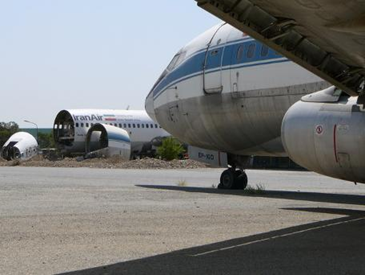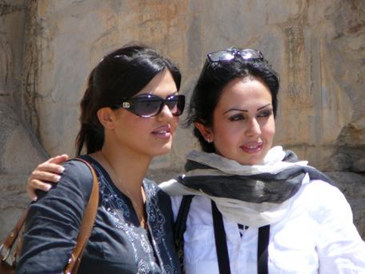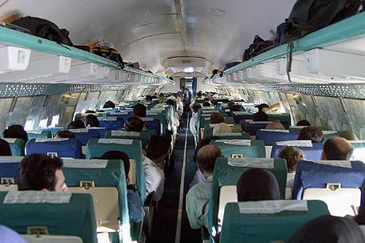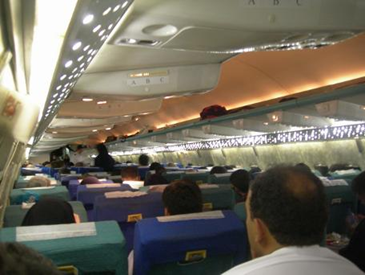Classic Jets over Iran
We fly to Tehran;- The last stronghold of Boeing 707s passengers jets
By Jan Koppen
|
In today’s world of ‘Stage III’ and Next Generation Jets, there are few options open to the aviation enthusiast seeking transport in a Boeing 707. For the more discerning connoisseur of vintage jet travel, the crème de crème is to sample the delights of the 707 in its original, non-hush kitted form.
The times that Western and North American airlines operated 707s are already two decades ago, but fortunately there is still one option left. Iran’s Service Artebaataat Havaaee Artesh (SAHA Air), the military transportation arm of the Islamic Republic of Iran Air Force (IRIAF) is still operating three non-hush-kitted Boeing 707-3J9Cs in a 162 all ‘tourist-class’ configuration, on several challenging routes within Iran. The World’s last passenger 707 stronghold is Tehran Tehran, the capital of the Islamic Republic of Iran, is also the last stronghold of Boeing 707s. Almost fifty years after first entering airline service, the Boeing 707, which always had an enviable reputation for reliability and sturdiness, is still operating its passenger-carrying role within Iran. In order to be able to fly in one of these aging classics, I headed for the mysterious capital of Iran this summer. Today, the Iran situation is reasonably calm, but in this area of the world peace is of a fragile nature. Besides taking a casual stroll through the centre of the city, I also visited the aviation exhibition centre at Mehrabad airport. Showpieces were an Islamic Iran Air Force DHC-4 Caribou, a Douglas B26 Invader, a Douglas DC-3A, an Iran Navy DHC-2 and an Iran Asseman Fairchild FH227. Next to the exhibition centre is the very interesting storage depot of Iran Air. Parked in several states of disrepair were; an Iran Air Boeing 747SP, five Boeing 737-200s, the fuselage of a 727-100 of Iran Air, one Iran Air Cargo’s 747-200F , the two Islamic Republic of Iran 727-100s (both are in good order) and still have their early 1970s VIP interior. Also present was an Air Universal Lockheed Tristar, an Iran Asseman Fokker F28-4000 and a Islamic Iran Air Force Fokker F27-600. Just around the corner of the museum one can have a good lunch in a former Iran Air 707 (EP-IRJ). Air Restaurant serves really nice chicken kebap with alcohol free beer in this former Iran Air flagship. Further a field, a former Iberia Airbus A300 is stored in a dreadful shape next to several IRIAF Fokker F27s, Falcon 20s, two SAHA Boeing 747 air tankers and the former Iraq Airways 747-200 YI-AGO, dressed in an all white shabby colors scheme. Opposite the International terminal is the military ramp of both the Iran Air Force and the Iran Navy. In addition the military transport arm of the IRIAF, SAHA Air also has several aircraft at this widespread tarmac. I counted 10 Boeing 707s, including the wreck of SAHA Air 707, EP-SHE which crash-landed at Mehrabad in April, 2005, plus seven Boeing 747-100/200 series, many Lockheed C-130s, Falcon20s, Fokker F27 troopships, Ilyushin 76s and a Lockheed Jetstar. Present at the various maintenance ramps at the International and domestic terminal side were two Iran Air Boeing 747SPs, an Air Universal Lockheed Tristar and an Iran Aseman Fokker F28. The IRIAF had parked on these tarmacs several Ilyushin 76s, two Falcon 20s of the Republican Guard, an IRIAF Jetstar, two Falcon50s and the governmental Boeing 737-200 EP-AGA. Star attraction was IRIAF’s Boeing 707-386C serial 1001. SAHA is still operating the venerable 707 in 2006 It was very hot with temperatures in the 40s Celsius on my departure day. I had planned the long-awaited 707 flight for the last day of my stay and I decided to head for the airport early in order to allow sufficient time for the anticipated stringent security procedures. I had purchased a ticket with SAHA Air for flight IRZ162 to the Holy city of Mashad in the far north-east of the country. I left my hotel and flagged down a taxi. It stopped at my feet and the driver shouted me to enter. After a short wrangle in true Iranian style, we agreed on a bottom price of $3. Tehran is polluted by its traffic, and the drivers are maniacs who have no regard for anyone. No one obeys any traffic signals or signs, and the pedestrians likewise cross anywhere they want, anytime they want. While gazing out of the window, I saw several large billboards with the image of Ayatollah Khomeini, and in the background, the snow-covered peak of Mount Damavand came into view. As we passed the enormous Tower of Freedom statue, near the airport, the familiar screeching whine of Pratt & Whitney turbofans became evident. Overhead a graceful Boeing 727, with flaps full down came in for final approach. As the three-holler roared over head, I spotted the distinguishing and mythical Homa logo’s adorning the numerous Iran Air tail fins. It had struck me, I had arrived safely at Merhabad Airport. Both, Ayatollah Khomeini and Khamenei, were looking down at us When I entered the pre-revolution, early 1970s-style, airport building, it was peak time and the departure hall was packed. Check-in was done professional and in an efficient manner. Seat selection was easy; - just pointing out on the seat-map where you want to sit. After the security check, I entered the shabby waiting lounge, in which a dozen or more billboard pictures of Ayatollah Khomeini, and the current supreme leader of Iran Ayatollah Ali Khamenei were stern looking down at us in a paternal manner. Suddenly an Iran Aseman Boeing 727-200 skimmed over the buildings during its takeoff run. With a sharp right hand turn over the city, the Boeing left a long smoking trail in the crystal blue sky. It seemed that nothing had changed in this location since the 1970s. I felt that I had traveled back in time! assengers in the lounge consisted, besides me, of well dressed Iranian businessmen, pilgrims, mullahs (Islamic clergy), muslim women dressed in black chadors, or more stylish, with headscarf and a long black manteau (overcoat). Keep in mind, black is the favorite color in Iran! Due to the political upheavals in the area, taking pictures or aircraft spotting at Mehrabad airport is strictly forbidden. Iran Air Tours flight 945 went down My flight was planned to depart at 1400 and while we were in line for boarding, it suddenly appeared to be delayed. No reason was given for this. The departure lounge became more packed as also all the other Mashad bound flights were delayed. After two and an half hours the word spread that a Tupolev 154 of Iran Air Tours had crashed at Mashad airport. My heart went beating must faster as I had planned to fly with Iran Air Tours the next morning. Next we received the news that the Tupolev suffered a mishap (some reports say a nose gear tire burst) while landing on runway 14L. The airplane swerved and caught fire, killing 28 passengers onboard. I expected that all the flights to Mashad would be cancelled but suddenly boarding time for my flight was announced and started immediately. It appeared that the SAHA Air flight was the first to land at Mashad airport after its reopening. Amongst the passengers was the minister of transport and several other high rank officials on their way to invest the crash. It gave me mixed feeling about the trip; as death was close by! How much longer can this workhorse last? As the 161 other passengers and I were driven to the aircraft, a glorious view of the ramp awaited us. Next to our SAHA classic Boeing 707, the tarmac was packed with several Tupolev 154s, Boeing 727s, Classic 747s and Airbus A300B2s of carriers like Iran Air Tours, Caspian, Mahan Air, Iran Aseman, Zagros, AriaAvia, Qeshm, Pars Cargo, Kish Air, and of course Iran Air. I will never forget this vintage ‘old-jets’ line up, reminiscent of the 70’s. Our assigned flight, IRZ162, was Boeing 707-3J9C EP-SHV. Having rolled-off the Renton production line in June 1976, she was delivered to the Imperial Air Force of the Shah of Persia. Our particular aircraft was allocated the Boeing serial number cn. 21125 and registered 5-8309. The tankers and transporters of the former Imperial Iranian Air Force were not KC-135s but converted 707-320Cs. Between 1976 and 1991, ship 21125 gave the Iran Air Force reliable service. In February 1991 she changed hands and became part of the SAHA Air 707 fleet. ‘SHV’ is not a particularly high-time airframe, as her daily air time is only a few hours. Nevertheless, it’s uncertain, how long this vintage Jetliner, can hold her title as a passenger airliner! Preparing the 707 for flight As we walked from the modern SAHA bus towards the forward cabin door, our ears were greeted with the welcoming roar of the ground power unit, providing the much needed air-conditioning. When standing close to the vintage jet, the beautiful lines of the 707 are so evident. The antenna for long-range HF communications thrusts forward from the upper tip of the vertical fin and is one of the distinctive recognition features. Inside the 30 year old airliner, the cabin was all I expected, and more – sporting the much hoped for original hat-rack interior, including configuration and fittings as delivered factory new to the Iran Air Force back in 1976. The all tourist class 707 sported under the open overhead racks, 1960s boat style PSUs. The seats were a bit worn-out and had an Easy Jet pitch. As the passangers were streaming onto the aircraft, I soaked up the atmosphere of this great airliner as much as possible. The 707 is an older aircraft and still has a bit of the ocean-liner about it, while the new generation wide-bodies tend to be all metal tubes full of seats and efficiency ! Responding to her own power Outside ‘SHV’, the Iran air ground staff worked with the flight crew. Through the still open cockpit door I could see the crew preparing for engine start up. With the ramp stairs withdrawn and doors sealed, our turbofan powered craft was cleared by the ground crew for engine start. An old ground power unit connected to the 707 starboard wing root was responsible for the pressurized air and changed its low hum brutally into a high-pitched racket. From silence came the deep-throated turn of the compressors as air pressure appeared in the the system and slowly, the enormous turbofan engines started to suck massive quantities of air through their main intakes and secondary inlet doors for their necessary thrust. With a small explosion in the engine hot section, number 3 came alive. Raging gas was rammed backwards. The crew fired up number 3 engine first to allow the air system pressure to build up in readiness for starting No. 4. When engine numbers 4, 2 and 1 were started in sequence, torrents of hot gas were building up behind the 707. As the engines started to settle down at idle power, the 707’s familiar high-pitch howling started to fill the upper level of my hearing senses. Meanwhile, the Iran Air ground engineer was positioned alongside the 707’s nose, ready to report any technical snag to the flight-crew. Quickly, the starter was disconnected, while the nose wheel chocks were removed. After the engines were whistling away, the cockpit crew got visual contact with the ground engineer. With a resolute "thumbs up" signal, the engineer indicated that everything was OK and that the Boeing was ready to roll. Simultaneously, and with a sudden roar, the four turbofan engines increased power for forward momentum. While the hot exhaust gasses were blasted backward out of the engines, the crew carefully eased the heavy airplane away from its stand. Propelled by Herculean power, the 707 stirred herself, the silver swept-back wings swaying, as she began to roll onto the taxiway. The thundering Jet rushes upward into the air Floating easily on her shocks, the 130-ton liner rolled along the concrete, her wings were flexing slightly from the ground shocks and I felt the wheels transmitted the vibration of tar strips over concrete. In the passenger cabin, 162 passengers of SAHA Air flight 162, surrounded by beautiful 1970s style appointments, gazed into space from their windows. The sound was muted. It was not silence within the cabin, but there was the lack of the pounding roar one expects within such vintage Jetliner. During the lengthy taxi, a routine safety briefing was given. Our big Boeing Jetliner poised at the edge of Theran Mehrabad airport active runway. Take-off would be along the compass direction of 290 degrees. The wind was from the north-east, a breeze drifted gently across the airport with a speed of three to five miles per hour. The temperature needle stood at an even 40 degrees Celsius. We finally reached the holding point for runway 29R. The nose wheel rolled onto the runway and ahead lay over 13,000 feet of concrete. ‘SHV’lined up and holded, in preparation of her airborne venture! Suddenly sound rose to a furious level, as the 707s four reliable high-hour JT3D-3B turbofans roared with greater authority. With the engines screaming, gases hurtled rearward from each engine with tremendous velocity and external sound rose to a furious level. All four engines gave maximum thrust. A sudden shock shuddered the length of the airplane and the nose bobbed up, as the eight main wheels, free from the restraint of the brakes, responded to the insistent demand of the four engines. Accelerating steadily, our 130 ton Boeing, at first moved with a painful, overwhelming weight, but quickly the giant rolled faster and faster. In half a minute 3000 feet had vanished, but our Silver Jet still accelerated. Bounded by the earth’s gravitational forces, she raced down the runway at about 170 miles per hour. Wind rushed against the leading edges of the wings permitting this winged mass of metal to break the bonds of gravity. Then our magnificent Silver Bird responded to the invisible demand of air flowing along her massive wings. With the nose gear tilted up from the runway and her tail section slowly dropping to the concrete, she started to rise. For a moment the 707 hurtled along, nose high, and still clamped to earth, but seeming eagerly to sniff at the sky. As we gained height an audible thud was noticeable as the weight of the airliner was removed from the landing gear. Seconds later, we felt the massive gear, retracting into its capacious wells. Finally, with a clean configuration, the 707 started to feel her way in her natural element. With a sharp right turn, she crossed the airport boundaries and we were rewarded with a magnificent view of downtown Tehran. In the north, Mount Damavand, the highest peak of the Elbruz mountain range, was visible in a horizon of haze. Meanwhile ‘SHV’ wings were flexing and bending in response to the invisible demands of air flowing past. In-flight service was limited In our initial climb to 26,000 feet via Airway Bleu 411, ‘SHV’ quickly proceeded eastbound for reporting point Sabzevar. As soon as we were established on our climb-out altitude, the passengers in the cabin began to mill around and socialize. Outside, several thousand feet below us, a bright white Tupolev 154 went harrowing past towing needle-like contrails from its shiny tail, knowing that our fuel-guzzling 707 would leave an even larger corkscrew of vapor spiraling away behind us. The turbofan engines were reasonably quiet and could barely be heard in the forward cabin above the rush of the almost 600 mph air stream. The four lovely ‘chador’ uniformed air hostesses were a highlight of our 75-minute flight sector. The air attended for my section turned out to be a lovely lady with mysterious eyes and most likely a attractive body, but unfortunately she was dressed in a nothing revealing black chador! In-flight service was limited to a slice of dried-up cake and a fruit juice can with a straw. Of course, no in-flight magazine onboard this semi-military flight, only a few SAHA Air 707 safety feature cards were in the pockets of the weary seats. In the meantime our Silver Jet flashed through thin air like a rocket while passing the great salt desert Daht-e Kavi, south-east of the Elbruz mountain range. After the blood-red sliver of the sun had split the sky, we entered the darkness as we approached Mashad. At the right wingtip a double green light gleamed coldly; at the left wingtip a double red light glowed – the notice of a Jetliner rushing through the darkened skies. Inshallah The old Pratt & Whitney JT-3Ds went quiet and the whispering roar of the slipstream followed the 707 down to 8000 feet for the inbound turn. The old girl shuddered and dipped as the slotted flaps eased out into the darkness rushing after the trailing edge. With Mashad in sight, ‘SHV’descended into a gray layer of wispy cirrus clouds which caused the Boeing to slightly buffet. Droplets of condensation formed on the windows, briefly obscuring my view. As our Boeing approached the outer marker for Mashad Airport, preparation was made for the final descent and we were able to hear the whine of the engines as the throttles were advanced to counteract the drag of the flaps. At base-leg, I got the Runway inside, and it lay like a night-time boulevard in an oil well, brightly lit by emergency white intensity incandescent. ‘SHV’ lumbered down the slightly off-set final towards the threshold of 36 and shortly afterwards, the Jet’s landing gear was lowered causing the noise level in the cabin to increase as the units disturbed the air. The threshold lights flickered beneath the fuselage and the cabin was lit by rushing flashes and racing shadows. It seemed there was silence in those last moments and I waited, counting, waiting for the bogies to touch and rumble. The aircraft bounced heavily twice before making more permanent contact, and finally we were down and roaring along the runway. Spoilers were deployed and the four engines went into full reverse. Bellowing and howling we tore down the runway. Brakes were applied and the plane hunched down, crouching on the tarmac as she sped along. ‘SHV’ slowed gradually at first and finally the nose dipped radically. On the right hand side the smoldering remains of the crashed Iran Air Tours Tupolev 154M (EP-MCF) came into view, still surrounded by fire trucks. A shudder went through my body but the mighty Boeing 707 had brought me safely to Mashad. The flight was most impressive and the flight-crew did a job well-done, which is a credit to SAHA Air’s longstanding 707 operations. Telling this to my neighbour, he calmly replied – “Son, he (the captain) has nothing to do with it. We were in the hands of God, - Inshallah!”. Gingerly a ramp agent guided IRZ162 onto its assigned hardstand position and the airliner came to a halt. The roar of its engines died away and our hard working engines were ticking as they cooled. A set of steps were pushed toward the aircraft, and so ended another "routine" SAHA Air Boeing 707 flight. A sterling job done! I had traveled aboard a wonderful classic, first-generation jet aircraft and enjoyed it very much. Nobody knows when the SAHA Air 707s will be retired from service. So if you want to fly one of the few remaining 707s still in service, now is the time otherwise you may miss out on a very enjoyable experience. For ‘SHV’; it is business as usual’. Another turnaround, 20 tonnes of fuel, another crew, another varied selection of passengers and another journey”. I want to thank; Guy van Herbruggen, Sam Chui, Konstantin von Wedelstaedt, Micheal Prophet, Johannes Krauth and Shary Shahram for the use of photo’s and help in preparting this article. |
|














